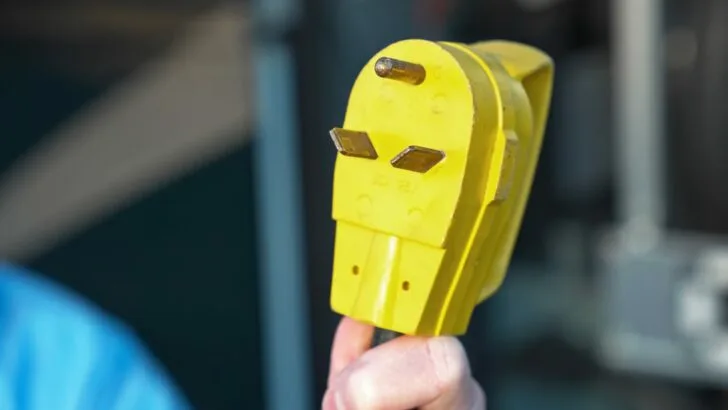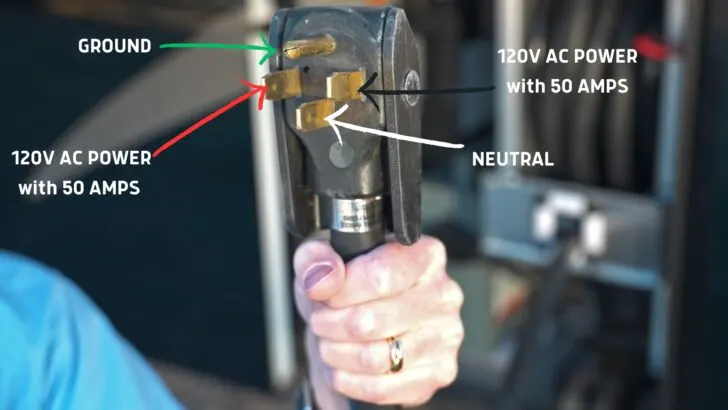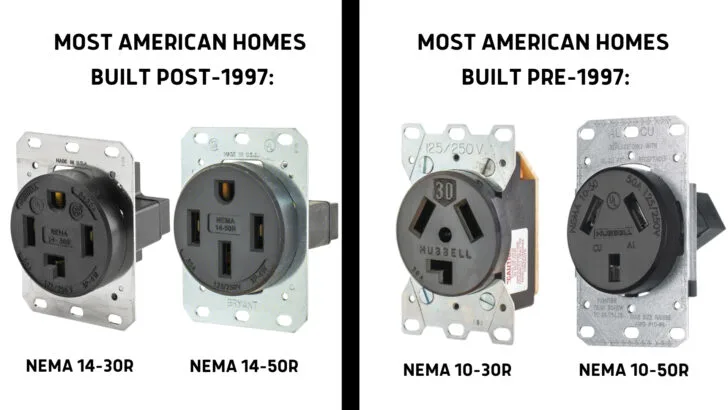“Can I plug my RV into a dryer outlet?” If only we had a nickel for every time we’ve heard that question over the past 20 years. But it stands to reason that RVers might wonder about the compatibility of their RVs with standard household outlets, including the dryer outlet.
Because a dryer outlet can use the same plug/prong configuration as an RV power plug, the risk of plugging an RV into a dryer outlet is real. But the fact that the plugs fit is precisely where the danger comes from. Because dryer outlets are often wired in a way that can cause significant electrical damage to the RV.
In this post, we’ll answer the question, “Can I plug my RV into a dryer outlet?” and explore the technical aspects of this topic and the essential safety considerations.
- 1) Understanding RV Electrical Systems
- 2) RV Outlet vs Dryer Outlet
-
3)
Can I Plug My RV Into a Dryer Outlet?
- 3.1) 30A RV Into a 10-30R 30A Dryer Outlet
- 3.2) 50A RV Into a 10-30R 30A Dryer Outlet
- 3.3) 30A RV Into a 10-50R 50A Dryer Outlet
- 3.4) 50A RV Into a 10-50R 50A Dryer Outlet
- 3.5) 30A RV Into a 14-30R 30A Dryer Outlet
- 3.6) 50A RV Into a 14-30R 30A Dryer Outlet
- 3.7) 30A RV Into a 14-50R 50A Dryer Outlet
- 3.8) 50A RV Into a 14-50R 50A Dryer Outlet
- 4) Important Safety Precautions for Plugging an RV Into a Dryer Outlet
- 5) Final Note
- 6) Free RVing Tips, Tricks, Reviews & Giveaways
Understanding RV Electrical Systems
Before getting into whether it’s safe and reasonable to plug an RV into a dryer outlet, it’s essential to understand the basics of RV electrical systems.
Most RVs are equipped with 30-amp or 50-amp electrical systems, though finding smaller rigs with 15/20-amp service is standard. While 15/20-amp RVs use the same plugs and power outlets found throughout a typical home, 30-amp and 50-amp rigs differ significantly from standard household plugs and outlets. The primary differences lie in the amperage requirements, power plug size, and configuration.
Let’s break 30-amp and 50-amp RV electrical systems down just a bit:
30A RV Electric Service
The smallest RVs on the road (think little pop-up trailers) with no air conditioners may have 15-amp electric service. Their 3-prong power plugs look the same as any grounded electrical appliance and can plug directly into typical household electric outlets. Besides these small rigs, most RVs have 30A or 50A electrical systems.
The vast majority of small-to-mid-size RVs use 30-amp, 120V AC power. This includes the average Class C motorhome, as well as many travel trailers and 5th wheels. If you look on the roof of an RV and see only a single air conditioning unit, it almost certainly has a 30-amp system.
But, the way to 100% confirm that a specific RV is 30-amp is by looking at the plug on the shore power cord. The photo below shows a 30-amp RV shore power plug. 30-amp plugs for RVs are classified as 120V NEMA TT-30P (“TT” stands for “Travel Trailer,” the “P” stands for “plug,” and seeing an “R” at the end would designate the matching “receptacle”).

This is a 30-amp RV shore power plug. Like a typical grounded 15-amp household plug, it has three prongs. But it’s a lot larger, and the two main prongs are at an angle.
30-amp RV service is widely available at campgrounds and RV parks throughout North America. It’s probably the most readily available for a reason — there are more 30-amp RVs on the road than any other type. Like a 15-amp outlet, it uses three wires — 1 hot, 1 neutral, and 1 ground. As the name implies, a 30-amp cord is rated to carry up to 30 amps of current safely.
For more details on 30-amp RVs, check out our post, The Complete 30-amp RV Plug Guide.
50A RV Electric Service
50-amp systems are typically found on larger RVs, such as big motorhomes and the largest 5th wheels & travel trailers. If you look at the roof of an RV and see two (or more) A/C units, it’s almost certainly a 50-amp rig. Unlike 15-amp and 30-amp RVs, 50-amp rigs require 240V service using four wires instead of three.

This is a 50-amp RV shore plug. It uses four wires and 240V power, split into two 120V legs. So even with 240 volts at the pedestal, the RV still runs off 120V power.
These big rigs have the largest RV plugs, with the 240V power split into two 120V legs. So the four wires are: two 120V hot leads, one neutral, and one ground. RV parks and campgrounds that offer 50-amp sites usually charge more for them, since larger RVs often use more power (think hot summer days with 2 or 3 air conditioners running). For obvious reasons, 50-amp RV power pedestals are typically installed at the largest campsites.
50-Amp RV plugs and their receptacles are classified as NEMA 14-50 (again, with an added “P” for “plug” or an “R” for “receptacle”).
Because there are two 50-amp legs, a 50-amp RV power pedestal technically provides one hundred amps! This is how a full-size 50-amp rig can run three air conditioning units and an electric range (induction cooktop) simultaneously. In comparison, a 30-amp rig can usually only power a single A/C unit and a few other low-draw items. A 50A RV has up to 12,000 watts of power available, compared to just 3,600 watts for a 30A rig.
For more details on 50-amp RV service, check out our post, The 50 Amp RV Plug: Power For Everything In Your RV!
RV Outlet vs Dryer Outlet
We’re all used to seeing 30A and 50A RV power outlets in RV parks and campgrounds all over North America. So, when we see a dryer outlet that appears identical to our rig’s power plug, it may be easy to assume they’re the same, and we can plug it right in. But are they wired the same?
In many (but not all) cases, the answer is an emphatic NO! That’s especially true for 30A RVs, which are at the highest risk/danger of severe electrical system damage if plugged into an improper dryer outlet. Most 3-prong dryer outlets (that look similar or identical to a 30A RV plug) are wired in a way that would feed 240V into our rigs, with potentially catastrophic results.
As mentioned, larger 50A motorhomes, 5th wheels, and travel trailers require 240V electric service at the pedestal. BUT… since it’s split into two separate 120V legs, nothing in the RV receives 240V. One 120V leg powers part of the RV, while the other 120V leg powers the rest of the RV.
This is the case in all but the largest (usually custom) motorhomes and bus conversions, where the manufacturer may wire 240V to the clothes dryer. Other than that, nothing in a typical 50A RV receives 240V power.
The big problem is that dryer outlets and RV plugs can look identical… and fit into each other. Even if they don’t fit, some adapters can make them fit… even if they’re not wired in a compatible way. That means you can easily insert your rig’s power plug into a ticking time bomb. Just because the plugs look the same doesn’t mean they’re wired the same.
Things get even more complicated because there are several different types of dryer outlets typically found in American homes, depending on when the house was built:
- If your home was built BEFORE 1997, you’re likely to have either a NEMA 10-30R or a NEMA 10-50R outlet. This includes two hot legs plus a neutral, but no (separate) ground.
- If your home was built IN/AFTER 1997, you probably have a more modern 30A (NEMA 14-30R) or 50A (NEMA 14-50R) outlet. These modern receptacles have a ground wire.
The following illustration should help you to identify which type of dryer outlet you have in your home:

A home electric dryer receptacle in the USA will likely be one of these four types. If your house was built after 1997, your dryer outlet is likely one of those shown on the left. If your home was built before 1997 (and has never been updated), you’ll have the type of receptacle shown on the right. A dryer plug and an RV plug may look the same, but a substantial self-inflicted wound may await anyone who assumes they’re wired the same.
Can I Plug My RV Into a Dryer Outlet?
Technically, the answer to this question depends not only on the RV but also on the dryer circuit. Let’s look at the various scenarios in which we can and cannot safely plug an RV into a dryer outlet. If you need help determining which outlet your dryer uses, you can look (carefully) on the face of the outlet itself to see if you can see the NEMA classification/number… or match what you see to the image above).
30A RV Into a 10-30R 30A Dryer Outlet
Absolutely not! This is where the trouble starts. Plugging a 30-amp rig into the dryer outlet in an older (pre-1997) home is a recipe for disaster.
A NEMA 10-30R 30A dryer outlet is wired for 240V service. A 30 amp RV outlet and plug are wired for 120V service on a single leg. They are not compatible with 240V service. Don’t ever plug a 30A RV into a 240V outlet.
And yes, we know that NEMA 10-30 to TT-30 adapters exist, but they are extremely dangerous. An adapter will not change the fact that a 10-30R outlet is wired for 240V service and a 30A RV is not. Nothing can make them compatible. If you plug your 30A RV into a 240V outlet, you’ll short out your equipment and may burn down your RV.
Even if you escape the worst using high-quality electrical system protection such as a Hughes Power Watchdog (see below), never plug a 30-amp RV into a 10-30R 30A outlet.
50A RV Into a 10-30R 30A Dryer Outlet
Can you? Yes, it’s possible. Should you? NO.
You really shouldn’t plug ANY RV into a 10-30R 30A dryer outlet. There’s no ground in the outlet, and you have a ground pin on your RV’s plug. You can find an adapter to feed a 50A RV, but the 10-30R outlet will still not be grounded and may cause shorts, shocks, or trip the circuit breaker.
30A RV Into a 10-50R 50A Dryer Outlet
A NEMA 10-50R 50A dryer outlet is wired for 240V service. Your 30A RV is not. No adapter can solve this incompatibility. Again, plugging a 30A RV into a 240V outlet will short your equipment if you’re lucky, and burn down your RV if you’re not.
If you’re using a surge protector, the excess voltage will almost certainly fry it. Even if you have a Power Watchdog (which has a replaceable surge/spike module), you’ll still cause the module to require replacement.
Don’t do it!
50A RV Into a 10-50R 50A Dryer Outlet
These 50-amp dryer outlets wired into homes built before 1997 do supply dual 120/240V service at 50A to your appliances, however, they don’t supply a ground wire – only a neutral wire. For this reason, RV owners should not plug any RV into an old 10-50R outlet.
You could argue that there’s an adapter that would allow you to connect your RV’s 50 amp plug, and the volts and amps will match up. But the lack of a ground in a 10-50R receptacle leaves you with a floating ground. This is unsafe! And it will likely trigger an alert/warning on any quality RV surge protector you’re using.
30A RV Into a 14-30R 30A Dryer Outlet
If your home has a 14-30R outlet, then it’s wired for 240V (your dryer’s heating element likely uses 240V, while the motor uses 120V). So, you might think that you can go right ahead and plug your 30A RV into a NEMA 14-30R dryer outlet, but that is not the case.
You can, however, use a 14-30P to TT-30R adapter to plug your RV into this receptacle. Essentially, the adapter will make it so that the TT-30R end is wired with 120V service which is just right for your 30A RV. And, since the 14-30R outlet is wired with both a neutral AND a ground, your RV’s electrical system will be properly protected.
- RV TT-30 plug charge from Dryer 14-30 outlet, 125V power adapter cord.
- Dryer 4-prong 14-30 male plug for 30 AMP input, right-angle type.
So, the bottom line here is that by using this type of adapter you can plug your 30A RV into a modern 14-30R 30A dryer outlet. Should you? We don’t think so, (more on that in our conclusion), but yes, it’s technically possible.
50A RV Into a 14-30R 30A Dryer Outlet
Yes, you can plug a 50A RV into a NEMA 14-30R 30A dryer outlet because this outlet provides split-phase 12o/240V power. However, there is a downside to this, and that’s the amperage restriction.
Remember that your RV is designed for 50A service. A 14-30R 30A outlet can only provide 30A. So once again, this means that if you try to run too many appliances at the same time, you can trip the circuit breaker on the house panel. This is no different than “dog-boning down” (see our video below) at a 30-amp RV park pedestal.
Just be sure to keep your power usage in mind.
30A RV Into a 14-50R 50A Dryer Outlet
It is possible to plug a 30A RV into a NEMA 14-50R receptacle, but you must use an adapter because the 14-50R outlet supplies 240V power. But, because the 14-50R receptacle is the same one used for 50-amp outlets at RV parks, the proper adapter will essentially re-align the connections to give you 120 volts on the RV side.
50A RV Into a 14-50R 50A Dryer Outlet
Yes, you can plug a 50A RV into a 14-50R outlet because it provides 50 amps of power at 240 volts with a ground, as required by your 50A RV. In addition, most RVs are made with 14-50P power inlets which means that you won’t even need an adapter to do this (i.e. this outlet is the same as the one used for 50-amp outlets in RV parks).

Safety always comes first in our book!
Important Safety Precautions for Plugging an RV Into a Dryer Outlet
Just because it may be technically feasible to connect an RV to a dryer outlet (using an adapter or not) doesn’t mean you should necessarily do it. If you plan to plug an RV into a dryer outlet, safety has to come first.
Use High-Quality Electrical System Protection
We absolutely never plug our rig in anywhere without our Hughes Power Watchdog. It’s the best RV electrical system protection we’ve ever used, and as the old commercial says, we wouldn’t leave home without it.
If you accidentally plug your rig into a dryer outlet that isn’t wired correctly for RV use, the Power Watchdog can save you from a massive self-inflicted wound. And since it’s not just dryer outlets that can have wiring issues, we never plug in without it anywhere. Oh, did we already mention we never plug our rig in without it? It’s a really big deal that bears repeating!
Make sure your RV is protected from low voltage, bad RV park wiring AND power surges when connecting to shore power with a Power Watchdog and/or Hughes Autoformer. We never hookup without ours (we...Show More
Make sure your RV is protected from low voltage, bad RV park wiring AND power surges when connecting to shore power with a Power Watchdog and/or Hughes Autoformer. We never hookup without ours (we have both), and know our RV's electrical system and all our electronics are being protected.
Watch our Hughes Autoformer video
Watch our Hughes Power Watchdog video
Save 10% on your entire purchase when ordering from Hughes!
Show LessUse Only the Proper Adapters
Any time plugs don’t match, you’ll need a dedicated RV adapter to ensure that the proper connection is made between the RV’s electrical system and the power outlet.
It’s crucial to use the right adapter based on the RV’s amperage needs (30 or 50 amps) and the type of dryer outlet available. Be certain that the adapter is specifically designed for RV use and compliant with all safety standards.
Verify Outlet Compatibility
Verify that the dryer outlet is in good condition and meets the electrical requirements of the RV. Use a high-quality multimeter to check the voltage on any outlet you’re considering plugging into.
- Measures both ac & dc current up to 400 amps, ideal for vehicles, rvs, marine boats & etc
- Ac/dc voltage, current, resistance, frequency, continuity, duty cycle & diode check
Monitor Power Consumption
Be mindful of the RV’s power consumption to avoid overloading the electrical system (when adapting a higher-amp capacity RV into a lower amp capacity oulet). This is another reason we love our Power Watchdog so much, since it’s bluetooth capabilities allow you to monitor your amp draw through their app.
Conduct Regular Inspections
Periodically inspect and maintain both the RV’s electrical system and the dryer outlet to promptly identify any potential safety issues.
Final Note
Although we’ve established that, technically, some RVs can be plugged into some dryer outlets within specific parameters, we don’t recommend doing so because the potential consequences are just too great.
If you want to use an old electric dryer connection to plug in your RV at your house, we have a suggestion: hire a qualified, licensed electrician to replace the outlet with a standard 30-amp (NEMA TT-30R) or 50-amp (NEMA 14-50R) RV outlet. Most importantly, be absolutely certain they understand that the outlet is for RV (120V) USE ONLY!
If you can’t 100% confirm that your electrician understands the difference between wiring an outlet for RV use rather than dryer use (which is what they surely do at least 99% of the time), find another electrician!
Once you’ve determined the safety of an electrical outlet, you still may need to adapt your rig up or down to connect. Here’s our video all about that:
Free RVing Tips, Tricks, Reviews & Giveaways
As 20-year full-timers, we share everything we’ve learned about RVing over the years. Join our online community to receive a wealth of great RVing knowledge delivered daily to your inbox.
Whether you’re a new RVer or a seasoned full-timer, you’ll love the wide range of RVing topics we cover. Don’t miss a single article or any of our famous Giveaways. Subscribe to our newsletter today!





John S.
Thursday 28th of December 2023
Well, this is one of those posts where the comments are worth reading plus add clarity and details.
Loren, Ralph and the geeks are all correct in what they say. Even if what they say can be said three or six different ways, depending on how many legs are being used.
Now the important question: will the new RVgeeks RV be announced soon?
My guess -> you looked at LUXE 5th wheels (I've had a personal fantastic 2.5 hour factory tour!) but after looking decided to to with a brand more suitable for what we motorcycle riders would call 'adventure riding'.
Also looking with interest on what you are replacing your long-serving Honda with. Should I make a horse before the cart joke here?
TheRVgeeks
Friday 29th of December 2023
Hi John! The time is coming when we'll be announcing our new RV... we're just waiting to have a better idea of when our delivery date is going to be, but since it hasn't even hit the production line, yet, we're not exactly sure when that will be. You'll just have to stay tuned with everyone else! 😉
As far as the cart and the horse? Well... we certainly are without our "horse" (MADP), so the "cart" IS a bit lonely these days! LOL!
Loren
Tuesday 26th of December 2023
a 50-amp RV power pedestal technically provides..... 50 amps. That's it, not 100. It has a 50 amp breaker for a reason, it's not 50 x 2. Please stop spreading this misinformation.
Ralph
Thursday 28th of December 2023
@TheRVgeeks, The problem with the RV Geeks article & answer to Loren are their considering the whole 12000 watts passing through a single leg. While the equation Volts times amps = watts is legitimate, trying to take the whole 100 amps (12000 wattage) through each leg will trip the breaker.
Geeks answer to Loren above said, "While no one circuit/side of the RV can use more than 50 amps, the entire RV has access to a maximum of 100 amps of usable power." I would disagree with this statement, they are ADDING the max wattage total for each leg. The entire RV has access to only 50 amps,- it is a TWO 50 amp circuits INCLUDING both both legs. 240 volts times 50 amps = 12000 watts.
Each leg is a 120 volt circuit, 120 volts times 50 amps = 6000 watts times two legs of circuit = 12000 watts. Any attempt to exceed the amps through 1 leg will result in tripping the breaker.
While I am not a degreed engineer, over the past 40 years I have built 4 home hydro-electric systems of 120-240, Volts AC power @ 60 Hz., (from 4 kw to 14 kw) the same power as in any US home. I have also set up my inverter system to push power into the grid (about 5000 kilowatt hours), enough power to power our home from July to Dec. each year. My experience with tripping breakers is as above.
I still like the Geeks comments on many subjects.
TheRVgeeks
Tuesday 26th of December 2023
Simple math appears to imply that a change from 30 to 50 equals a 1.66 times increase. So to understand why a 50-amp plug is capable of providing 12,000 watts of power, compared to just 3,600 watts from a 30-amp plug (a 3.33 times increase), one first needs to understand where the 50-amp plug got it's name. It's because it does indeed provide 50-amps of current... at 240 volts. But RVs run on 120 volts.
So some more simple math explains why 50A RVs actually have so much power available:
A 50-amp outlet on an RV pedestal is a split-phase 120/240V supply. The breaker installed is double pole, with one breaker for each 120V leg of the circuit. At 240V, the circuit can supply a maximum of 50A. Assuming a power factor of 1 (perfect efficiency): Volts x Amps = Watts. That means 240V x 50A = 12,000 Watts of available power.
But the RV splits the two legs apart, using each for 1/2 of the RV's circuits/loads. So you have 2 x 120V circuits instead. Reapplying a variation of the above rule, we can change the equation to: Amps = Watts ÷ Volts. So: 12,000 Watts ÷ 120V = 100 Amps of power.
While no one circuit/side of the RV can use more than 50 amps, the entire RV has access to a maximum of 100 amps of usable power.